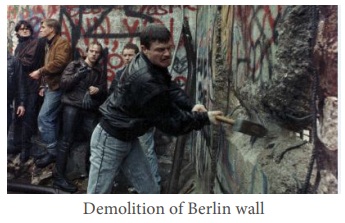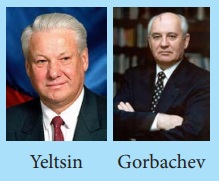The World after World War II - Fall of Berlin Wall and End of Cold War Era | 10th Social Science : History : Chapter 4 : The World after World War II
Chapter: 10th Social Science : History : Chapter 4 : The World after World War II
Fall of Berlin Wall and End of Cold War Era
Fall of Berlin Wall and End of
Cold War Era
The
division of Germany into West (Federal Republic of Germany) and East (German
Democratic Republic) led to glaring differences in living standards. West
Berlin’s economy became prosperous thanks to the support received from the West
under the Marshall Plan. In contrast the USSR had little interest in developing
the economy of East Berlin. Further, people in East Berlin suffered from lack
of democracy and freedom. Therefore, people of East Berlin moved to West Berlin
in large numbers. In West Berlin, on the other hand, there was a fear that the
Soviets could use military force to take West Berlin. In this context, East
Germany began to construct a wall in 1961 which virtually cut off West Berlin
from East Berlin and the surrounding East German areas. It was heavily guarded
with watch towers and other lethal impediments to stop people from the East. In
the late 1980s, as USSR’s hold over Eastern European countries was weakening, a
mass of people assembled on 9 November 1989 on both sides of the wall and began
to demolish it. Germany was officially reunited on 3 October 1990. The Berlin
Wall was more than just a physical barrier. It was a symbolic boundary between
communism and capitalism. With the fall of the Berlin Wall, followed by the
collapse of the Soviet Union, the Cold War era came to an end.

Helmut Kohl,
Chancellor of West Germany from 1982 to 1990, and played a crucial role in integrating East
Germany into West Germany in 1990. He thus became the first chancellor of a
unified Germany after forty five years of division. With French president
Mitterand, Kohl was the architect of the Maastricht Treaty, which established
the European Union (EU) and the euro currency.
Disintegration of the Soviet Union
In the
1970s and early 1980s the Soviet Union continued to retain a strong and
dominant position in international politics. However, its economy was
suffering, and was unable to match the productive capacity of the first world.
In 1985, Mikhail Gorbachev took over as head of the USSR. Gorbachev spoke about
the need for openness (Glasnost) and reform (perestroika). But his commitment
to reform, apart from opposition within the ruling communist party, did not
match the resources available to USSR. In the middle of the 1980s about one
third of the total GDP was going to the military. In order to maintain a parity
with the US, in the context of President Reagan’s Star Wars programme, it
became necessary for the Soviet Union to allocate more funds to the military.
The increase in military budget further strained the Soviet economy.
The year
1988 saw the first mass protests –first in Armenia, and then in the Baltic
States. Earlier Soviet regimes had used severe repression to quell such
uprisings. Gorbachev could not take recourse to such brutal measures. The
Chernobyl Disaster, a major accident in a nuclear plant in Ukraine, in 1986,
was another blow. Gorbachev made moves to stabilise his position by reliance on
conservative forces in 1989 and 1991. But on each occasion he was interrupted
by massive miners’ strike which came close to cripple the country’s energy
supplies.
The East
European communist states, under the Soviet umbrella, were also in a deep
economic and social crisis. Gorbachev’s decision to loosen the Soviet control
on the countries of Eastern Europe created an independent, democratic momentum.
A series of workers’ strikes undermined the communist regimes first in Poland
and then in Hungary. A wave of demonstrations that swept East Germany led to
demolition of the Berlin Wall in 1989.
Perestroika (‘restructuring’) refers to
the programme introduced by Mikhail Gorbachev in the late 1980s to
restructure Soviet economic and political system. Along with the policy of
‘Glasnost’ (‘openness), Perestroika was intended to energize Soviet economy
which was lagging behind the developed countries of the capitalist world.
Glasnost (‘openness’) was a policy of
ideologically openness introduced by Mikhail Gorbachev along with
Perestroika in the 1980s. Under Glasnost there was more openness, writers who
had been censored earlier were rehabilitated, and there was space for criticism
of politics and government.
Subsequent
to it, regimes in Czechoslovakia, followed by Bulgaria, fell. An attempt by
Romania’s Nicolae Ceaușescu to resist the wave of change by shooting down
demonstrators ended in his execution by a firing squad (December 1989) under
the command of his own generals. The televised images of the shooting and the
fall of the Berlin Wall galvanized the process of the breaking up of the
communist world. In six months the political map of half of Europe had been
redrawn.
Yeltsin was first an ally of Gorbachev. However, as Mayor of
Moscow, Yeltsin won great popularity as a champion of political and economic
freedom. With Gorbachev’s introduction of democratic elections for the Soviet
parliament, Yeltsin was returned to power with overwhelming support of a Moscow
constituency in 1989. The following year he was elected President of Russia
over Gorbachev’s objections. President Yeltsin advocated greater autonomy of
the Republic, with executive presidential system that would allow him to govern
independently of parliament.

Gorbachev
made a last attempt to take a hard line against the disruptionist only to be
challenged by a second great miners’ strike in 1991and huge demonstrations in
Moscow. In response, conservative forces in his government attempted to take a
hard line without Gorbachev. They used troops in Moscow to stage a coup, and held
Gorbachev under house arrest. But other military units refused to back them and
as a result power fell into the hands of Boris Yeltsin, a reformer backed by
the West.
In the
meantime, three Baltic States had formally left the Soviet Union. They were admitted
to the U.N. as independent countries: Estonia, Latvia, and Lithuania. In
November 1991 eleven republics (Ukraine, Georgia, Belarus, Armenia, Azerbaijan,
Kazakhstan, Kyrgyzstan, Moldova, Turkmenistan, Tajikistan and Uzbekistan)
announced secession from the Soviet Union. Instead, they declared they would
establish a Commonwealth of Independent States. On 25 December Gorbachev
announced his resignation. For six days the Soviet Union continued to exist
only in name and at midnight on 31 December 1991, it was formally dissolved.
The USSR was no more.
Related Topics